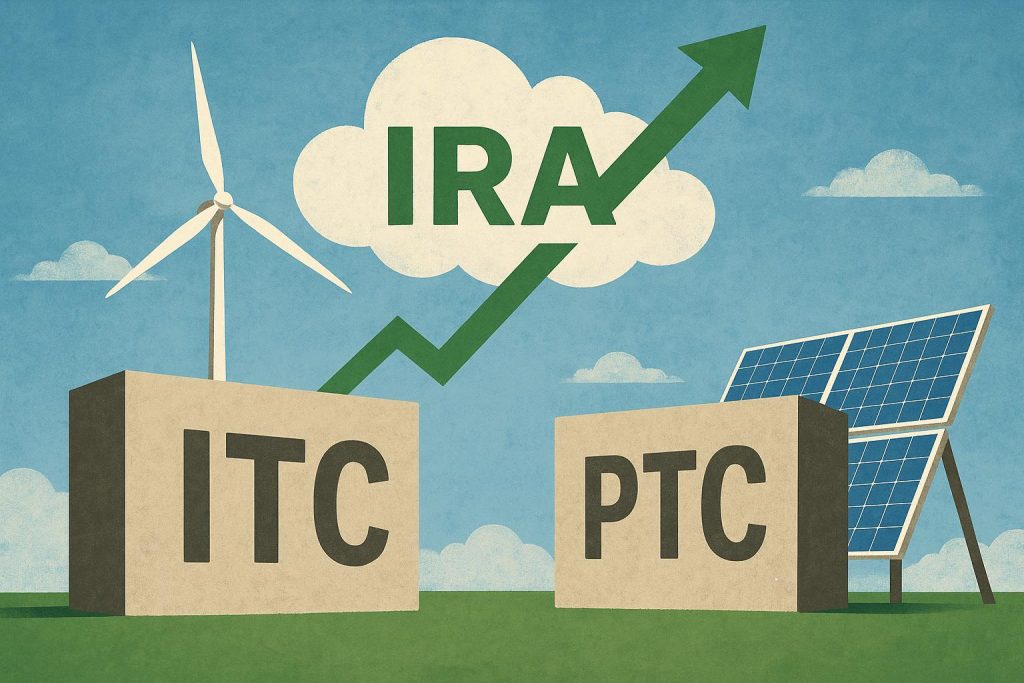The entire world has been shifting towards clean, sustainable energy for a while now. The USA picked up on this transition quite early and has been empowering its government-backed incentives. The Production Tax and the Investment Tax Credit are just a few of many financial incentives provided in the country to encourage more participation in renewable energy projects.
In the year 2022, the USA gave a go-ahead to the Inflation Reduction Act. And with this act, renewable energy projects have been significantly modified. Will these changes reshape the renewable energy landscape? The answer does seem promising!
ITC vs PTC
The Investment Tax Credit-ITC and the Production Tax Credit-PTC are two of the most popular federal tools used to accelerate renewable energy growth in the USA.
These credits reduce overall project costs, make clean energy generation more competitive with conventional energy sources, and to extent, encourage investment in renewable energy technologies.
The major factor in the ITC vs PTC discussion is:
- ITC: It enables investors in a project to claim a one-time tax credit equal to a percentage of the project cost.
- PTC: It grants tax credits dependent on the volume of energy generated by a renewable energy project over a defined time period, usually ten years.
List of ITC vs PTC programs:
| Investment Tax Credit | Production Tax Credit | ||
| Section | Description | Section | Description |
| §48 ITC | Energy credit | §45 PTC | Electricity produced from certain renewable sources |
| §48E ITC | Clean electricity investment credit | §45Y PTC | Clean electricity production credit |
| §30C ITC | Alternative fuel vehicle refueling equipment credit | §45Q PTC | Credit for carbon dioxide sequestration |
| §48C ITC | Advanced energy project credit | §45U PTC | Zero-emission nuclear power production credit |
| §45Z PTC | Clean fuel production tax credit | ||
| §45V PTC | Clean hydrogen production tax credit | ||
| §45X PTC | Advanced manufacturing production credit | ||
How the ITC and PTC Have Changed Under the Inflation Reduction Act
The Inflation Reduction Act (IRA) of 2022 has reshaped clean energy incentives within the United States by amending, expanding, and prolonging significant programs like ITC and PTC. The amendments will speed up the country’s transition to renewable energy by opening up eligibility, driving value, and making taxable and non-taxable more accessible for individuals.
Increased Value of the ITC and PTC
Under the IRA, the ITC and PTC have both experienced significant boosts in their potential value.
- Under smaller projects with less than 5 MW, the ITC now extends to as much as 70% of total project costs, a whopping increase from the earlier 26%. This is a 169.2% value jump in potentiality.
- Likewise, the PTC has been increased to $30 per MWh for utility-scale projects, from the former $26 per MWh, indicating a 15.3% boost.
Expanded List of Eligible Technologies
The IRA has expanded the range of technologies that qualify for both the ITC and PTC. This broad inclusion supports a wider spectrum of clean energy innovations and encourages investment in emerging technologies.
Under the ITC, eligible technologies now include:
- Solar
- Fiber-optic solar
- Geothermal
- Qualified fuel cells
- Microturbines
- Combined heat and power systems
- Small wind
- Geothermal heat pumps
- Waste energy recovery
- Stand-alone battery storage
- Biomass technology
- EV charging
- Microgrid controllers
Under the PTC, eligible technologies now include:
- Solar
- Wind
- Biomass (closed and open loop)
- Geothermal
- Landfill Gas
- Hydropower
- Marine and Hydrokinetic Systems
- Hydrogen
- Nuclear Energy
New Eligibility for Non-Taxable Entities
A major shift under the Inflation Reduction Act is the extension of benefits to non-taxable entities, such as state and local governments, tribal authorities, schools, churches, and non-profits. Traditionally, these organizations could not claim tax credits. However, now, through direct pay and transfer provisions, they can access the same incentives as taxable entities.
Direct pay allows these organizations to receive a direct payment from the IRS instead of a tax credit. Also, the deduction transfer option under Section 179D enables them to transfer deductions to project designers such as architects, engineers, or energy service providers.
Note: Organizations can avail of clean energy tax credits for only the equipment that is placed in service between January 1, 2023, and December 31, 2032.
Bonus Opportunities to Maximize Value
Projects can also increase the value of their credits by fulfilling specific standards. These bonus incentives make renewable projects more beneficial.
For the ITC, the base rate starts at 6%, but can increase through bonuses:
- 24% for meeting wage and apprenticeship requirements
- 10–20% for locating in low-income communities
- 10% for projects in energy communities
- 10% for using domestic materials
Similarly, the PTC base rate is $5/MWh, with additional bonuses:
- $20/MWh for prevailing wage and apprenticeship standards
- $2.5/MWh each for domestic content and energy community qualifications
Accelerating Clean Energy Deployment
The Inflation Reduction Act has been improving the financial credibility of clean energy investments across the USA. By expanding eligibility, increasing incentive values, and assuring flexible access mechanisms, the revised ITC and PTC allow private and public entities to invest in green infrastructure, improve operating efficiency, and support further national decarbonization goals.
Conclusion
The Inflation Reduction Act has helped restructure renewable energy incentives in the USA. With the expansion of ITC and PTC, the act provides developers and investors with long-term predictability and flexibility. They enhance the economic foundation for solar, wind, and other clean energy projects and encourage manufacturing growth and modernization at the same time. As the renewable energy industry moves into a new era of opportunity, smart planning and project development will remain key to achieving the potential of these incentives.




